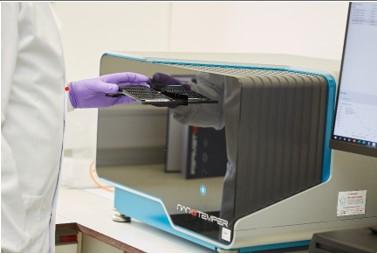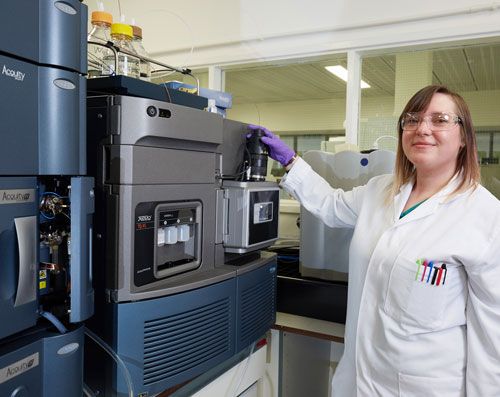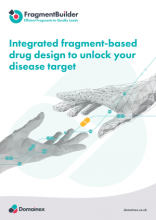- About
-
Services
-
Offerings
- Offerings
- ADME and Bioanalytical Sciences
- Analytical Chemistry
- Assay Development
- Biochemical Assays
- Biophysical Assays
- Cell Based Assays
- Computational Chemistry
- Fragment and Compound Screening
- Integrated Drug Discovery Services
- Medicinal Chemistry
- Project Management and Consultancy Services
- Protein Expression and Purification Services
- Structural Biology
- Synthetic Chemistry
- Virtual screening
-
Research Phases
- Research Phases
- Hit Identification
- Hit to Lead
- Lead Optimisation
- Therapeutic Areas
- Target Classes
-
Approaches & Techniques
- Approaches & Techniques
- CDH (Target Gene Fragmentation)
- Cryogenic Electron Microscopy (Cryo-EM)
- Differential Scanning Fluorimetry (DSF) and nanoDSF Services
- Direct-to-Biology (D2B)
- Dynamic Light Scattering (DLS)
- eProtein Discovery
- Flow Cytometry
- Fragment Based Drug Discovery (FBDD)
- FragmentBuilder
- Grating-Coupled Interferometry
- High Throughput Screening
- Isothermal Titration Calorimetry (ITC)
- LeadBuilder
- PoLiPa (Membrane Protein Solubilisation)
- Spectral Shift and MST Services
- Structure Based Drug Design (SBDD)
- Surface Plasmon Resonance (SPR)
- X-ray Crystallography
-
Offerings
- Library
- News & Events
- Careers
FragmentBuilder: Fragment-Based Drug Discovery and Design
Integrated fragment-based screening to unlock disease targets

FragmentBuilder is Domainex’s Fragment-Based Drug Discovery (FBDD) platform that enables us to rapidly identify hits against your chosen target. Starting from a target gene, Domainex deploys its FBDD expertise in protein science, assay biology and medicinal chemistry to discover tractable, patentable leads cost-effectively.
Why choose FragmentBuilder?
- Domainex is a leading expert in the generation and interpretation of biophysical data and has a proven track record as a fragment screening service provider
- FragmentBuilder includes access to the exclusive Domainex fragment library:
- Expertly selected
- Diverse
- Good coverage of bioactive fragment space
- A range of primary screening techniques are established
- Our X-ray crystallography platform will support fragment elaboration in real time
- A fully integrated service is available or individual modules can be selected and tailored to your needs
The Process

High-Quality Protein Supply
Our highly experienced Protein Science team can prepare crystallography-grade proteins for you in multi-milligram quantities using standard bioinformatics and literature-informed approaches or, if required, by deploying our proprietary technology Combinatorial Domain Hunting (CDH).
Diverse Fragment Collection
Domainex has curated a diverse collection of over 1,000 fragments offering novel potential starting points, which are available for immediate screening against your target.
- A multi-parameter scoring function employed for compound selection
- Molecular fingerprints generated and compared with those of ChEMBL fragments to ensure good coverage of bioactive space
- All compounds are soluble at 1mM in 1% DMSO
Our library adheres to the key principles of fragment-based drug discovery (FBDD): low molecular weight, a limited number of hydrogen bonding groups, a balance of polarity and lipophilicity, and a small number of rotatable bonds.
Fragment Based Screening
Screening is a key component of the FragmentBuilder platform, and naturally Domainex uses methods that have a good track record of being able to detect the relatively weak binding of fragments.
At the heart of the platform is rapid fragment screening. We typically use the biophysical techniques of spectral shift, MicroScale Thermophoresis (MST) or Grating Coupled Interferometry (GCI). Domainex will investigate multiple techniques in parallel so that we can select the right technology for your target.
Spectral Shift and MST
Domainex has invested in both the 384-well-based Dianthus NT.23PicoDuo and capillary-based Monolith NT.Automated high-end instruments from NanoTemper Technologies GmbH. Assays on these complimentary systems can be established quickly and allow for the efficient screening of fragment collections in a matter of just a few days, while also minimising usage of your target protein. Over the last 5 years, Domainex has established itself as the leading provider of fragment screening using MST, having deployed this unique technology to complete dozens of screens For further information visit our Spectral Shift and MST webpage.
GCI
Domainex has also invested in the Creoptix WAVEdelta platform. GCI is analogous to Surface Plasmon Resonance (SPR). In both techniques, the target protein is immobilised onto specialised sensor chips and the passage of analytes over the chip’s surface are monitored as time-dependent changes in refractive index, which can indicate bi-molecular interactions. GCI is more sensitive than SPR and generates fast and accurate measurements of kinetic rates. Visit our GCI page for more information.
We also use a range of alternative biophysical screening methods if these are required. We have found HTRF to be a robust and very useful technique in some cases (see our white paper here). One of the advantages of the MST, GCI and HTRF methods is that they are generally straightforward to use saturating concentrations of competitive ligands to bias the fragment hits towards alternative binding sites, and this can often be attractive to our clients.
Covalent fragment screening
Domainex also perform covalent fragment screening. Targeted covalent inhibitors have the potential advantages of prolonged duration of action, improved potency and high levels of selectivity for the target of interest. Covalent fragments can be detected by mass spectrometry which can be beneficial if a sensitive biophysical detection method, essential for classical fragment screening, cannot be established for the protein target of interest. Domainex's covalent fragment library, which includes a diverse range of warheads, is ready for immediate screening. Once hits are identified, our GSH reactivity counter-screen provides real time kinetics and we can identify the fragment binding site by performing protein digest and peptide mapping studies. See our poster “Covalent Fragment Screen using QToF analysis” for an example of covalent fragment screening work carried out at Domainex and find out more on our dedicated covalent inhibitors page.
After the Screen
With confirmed fragment hits in hand, the next step is to increase their affinity and establish some initial structure-activity relationships. We do this through a combination of targeted acquisition of related compounds selected from our databases of commercially available compounds, and the synthesis of well-designed compound arrays around the fragment hits. The Domainex team of skilled medicinal and computational chemists are highly experienced in fragment-based drug discovery (FBDD) and know how to do this. They understand the chemistry around our fragments and can quickly synthesise analogues and elaborated compounds to increase their affinity. At the same time, we recommend that our structural biologists obtain high-resolution crystal structures of fragments bound to the target of interest, which can help guide this elaboration process.
For a FBDD case study please see: G9a: A FBDD programme to identify lysine methyltransferase inhibitors for the treatment of cancer.


Download the Brochure
FragmentBuilder is a fully integrated fragment-based drug design (FBDD) platform that delivers well qualified starting points for lead optimisation. Starting from your drug target, we provide the following suite of services to advance your FBDD project seamlessly...
Case studies
Start your next project with Domainex
Contact one of our experts today